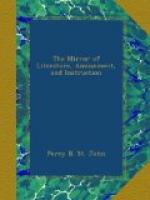[Footnote 5: For Two Illustrations and Notice of this interesting work, See Mirror, vol. xix. p. 337 to 342; whence the above origin of the work has been quoted.]
In person, Mr. Irving is of middle height; and, according to a contemporary, of “modest deportment and easy attitude, with all the grace and dignity of an English gentleman."[6] Another describes him as “a most amiable man, and great genius, but not lively in conversation.” His features have a pleasing regularity, and are lit up, at every corner, with that delightful humour which flows in a rich vein throughout his writings, and forms their most attractive charm.
[Footnote 6: Fraser’s Magazine.]
Having noticed Mr. Irving’s principal works, we have left but little occasion to speak of his general style. A contemporary has denominated him the “Goldsmith of the age;” and of Goldsmith we must remember that, in his epitaph, Dr. Johnson observes: “he left no species of writing untouched, and adorned all to which he applied himself”—a tribute which can scarcely be appropriately paid to any writer of our time. However, we know not any author that Mr. Irving so much resembles as Goldsmith: although no imitator, his style and language forcibly remind us of that easy flow so peculiar to the Citizen of the World. But, we have higher warrant for this parallel. “It seems probable,” observes a critical writer of considerable acumen, “that Mr. Irving might prove no contemptible rival to Goldsmith, whose turn of mind he very much inherits, and of whose style he particularly reminds us. Like him, too, Mr. Irving possesses the art of setting ludicrous perplexities in the most irresistible point of view, and we think equals him in the variety of humour."[7]
[Footnote 7: Quarterly Review.—Such is the variety displayed in the Salmagundi; the papers were supposed to be the joint efforts of several literati.]




